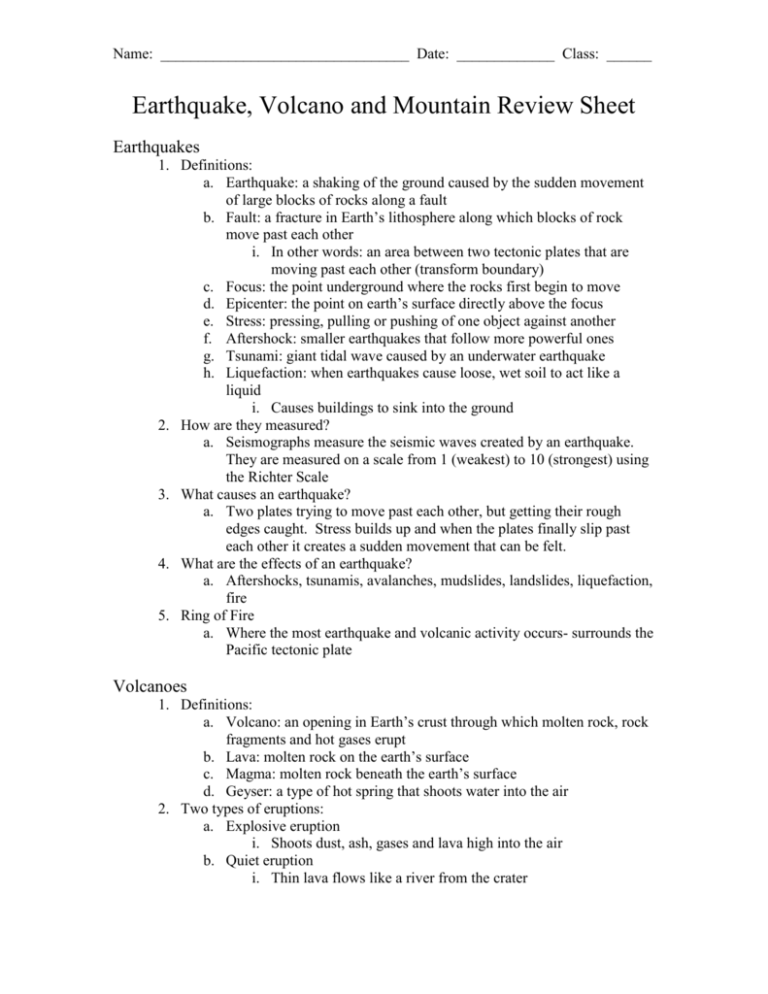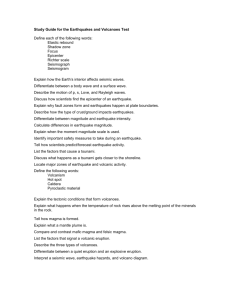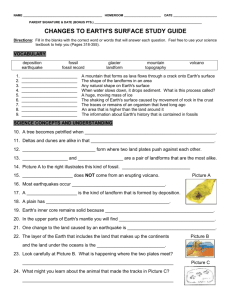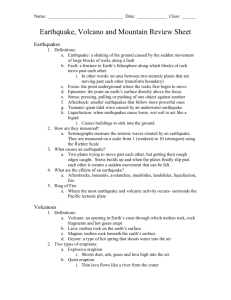Earthquake, Volcano and Mountain Review Sheet
advertisement

Name: _________________________________ Date: _____________ Class: ______ Earthquake, Volcano and Mountain Review Sheet Earthquakes 1. Definitions: a. Earthquake: a shaking of the ground caused by the sudden movement of large blocks of rocks along a fault b. Fault: a fracture in Earth’s lithosphere along which blocks of rock move past each other i. In other words: an area between two tectonic plates that are moving past each other (transform boundary) c. Focus: the point underground where the rocks first begin to move d. Epicenter: the point on earth’s surface directly above the focus e. Stress: pressing, pulling or pushing of one object against another f. Aftershock: smaller earthquakes that follow more powerful ones g. Tsunami: giant tidal wave caused by an underwater earthquake h. Liquefaction: when earthquakes cause loose, wet soil to act like a liquid i. Causes buildings to sink into the ground 2. How are they measured? a. Seismographs measure the seismic waves created by an earthquake. They are measured on a scale from 1 (weakest) to 10 (strongest) using the Richter Scale 3. What causes an earthquake? a. Two plates trying to move past each other, but getting their rough edges caught. Stress builds up and when the plates finally slip past each other it creates a sudden movement that can be felt. 4. What are the effects of an earthquake? a. Aftershocks, tsunamis, avalanches, mudslides, landslides, liquefaction, fire 5. Ring of Fire a. Where the most earthquake and volcanic activity occurs- surrounds the Pacific tectonic plate Volcanoes 1. Definitions: a. Volcano: an opening in Earth’s crust through which molten rock, rock fragments and hot gases erupt b. Lava: molten rock on the earth’s surface c. Magma: molten rock beneath the earth’s surface d. Geyser: a type of hot spring that shoots water into the air 2. Two types of eruptions: a. Explosive eruption i. Shoots dust, ash, gases and lava high into the air b. Quiet eruption i. Thin lava flows like a river from the crater Name: _________________________________ Date: _____________ Class: ______ 3. Three types of volcanoes: a. Cinder cone i. Explosive eruption ii. Mountain is small and has steep sides b. Shield i. Quiet eruption ii. Mountain covers a large area, sides are gently sloped, domeshaped c. Composite cone i. Explosive eruption then a quiet eruption follows ii. Mountain is large, sides are steep, and mountain is cone-shaped Mountains 1. Definitions: a. Mountain: an area of high land or rock which rises above the surrounding low lands 2. How do mountains affect life on earth? a. Mountains affect the wind, temperature, and water supply of an area i. This controls what will grow and the types of animals that can live there 3. Types of mountains: a. Folded (most common type of mountain) i. Formed when a large force pushes the folded layers up from two lithospheric plates colliding ii. Looks like a wave b. Dome i. Formed when magma builds up pressure beneath the surface and pushes up on the rock ii. Smoother, rounded peak c. Fault-block i. Formed when large blocks of the earth’s crust are lifted and tilted by faulting ii. Steep sides 4. Mountains are eroded away by wind and water- become smoother 5. Volcanoes are mountains! Name: _________________________________ Date: _____________ Class: ______ Earthquake, Volcano and Mountain Review Sheet You may use 1 page handwritten notes for your test on Monday 01-24-14 Your answers to these items and/or your notes sheet is worth up to 5 pts. For notes, must be written on a lined/blank paper. Earthquakes 1. Definitions: a. Earthquake: b. Fault: c. Focus: d. Epicenter: e. Aftershock: f. Tsunami: g. Seismograph h. Seismogram 2. How are they measured? Brief Description a. Mercalli Scale b. Richter Scale c. Moment Magnitude Scale d. How many stations data needed to locate epicenter? e. Measure an S-P interval using a graph 3. What causes an earthquake? 4. Ring of Fire – describe 5. Seismic Waves a. P-Wave b. S-Wave c. Surface Waves 6. Where do most earthquakes occur? Volcanoes 1. Definitions: a. Volcano: b. Lava: c. Magma: d. Dike e. Sill 2. Two types of eruptions, describe Name: _________________________________ Date: _____________ Class: ______ a. Explosive eruption a. Quiet eruption 3. Three types of volcanoes, describe a. Cinder cone b. Shield b. Composite cone 7. Largest type ? Most common? 8. Where do most volcanoes occur? 9. How have humans adapted and benefitted from volcanic regions? 10. Two ways people can use volcanoes for their health/wellness advantage Continental Drift, Plate Tectonics 1. Definitions: a. Pangaea b. Gondwanaland c. Laurasia d. Crustal Plates e. Lithosphere f. Aesthenosphere g. Subduction Zone 2. Alfred Wegener a. Evidence Provided for Continental Drift Theory b. Why not largely supported 3. Tectonic Plates Theory a. Evidence supporting 4. Divergent- Convergent – Transform Boundary explain 5. What is the deepest layer into Earth we have drilled into? Name: _________________________________ Date: _____________ Class: ______ Earthquake, Volcano and Mountain Review Sheet Earthquakes 1. Definitions: a. Earthquake: a shaking of the ground caused by __________________ ____________________________________ b. Fault: a fracture in Earth’s lithosphere along which _______________ __________________________________ i. In other words: an area between two tectonic plates that are moving past each other (_________________________) c. Focus: ___________________________________________________ _____________________ d. Epicenter: ________________________________________________ _____________________ e. Stress: pressing, pulling or pushing of one object _________________ f. Aftershock: _____________________ that follow more powerful ones g. Tsunami: giant tidal wave caused by ___________________________ _____________________________ h. Liquefaction: _____________________________________________ ________________________________________ i. Causes buildings to sink into the ground 2. How are they measured? a. Seismographs measure ______________________________________ ___________________. They are measured on a scale from ________ ___________________________________ 3. What causes an earthquake? a. Two plates trying to move past each other, but getting their rough edges caught. _____________________________________________ _________________________________________________________ 4. What are the effects of an earthquake? a. _________________________________________________________ ________________________________ 5. Ring of Fire a. Where the most earthquake and volcanic activity occurs- ___________ _______________________________ Volcanoes 1. Definitions: a. Volcano: _________________________________________________ ______________________________ b. Lava: molten rock __________________________ c. Magma: molten rock _____________________________ d. Geyser: ___________________________________________________ Name: _________________________________ Date: _____________ Class: ______ 2. Two types of eruptions: a. Explosive eruption i. __________________________________________________ b. Quiet eruption i. __________________________________________________ 3. Three types of volcanoes: a. Cinder cone i. ___________________________ ii. ______________________________________ b. Shield i. __________________________ ii. ___________________________________________________ _______________________ c. Composite cone i. ___________________________________________________ ii. ___________________________________________________ __________________________ Mountains 1. Definitions: a. Mountain: _______________________________________________ _________________________________ 2. How do mountains affect life on earth? a. Mountains affect __________________________________________ _____________________ i. This controls ________________________________________ _______________ 3. Types of mountains: a. Folded (most common type of mountain) i. Formed when _______________________________________ _________________________________ ii. Looks like ___________ b. Dome i. Formed when _______________________________________ __________________________________ ii. ______________________________ c. Fault-block i. Formed when _______________________________________ ___________________________ ii. _______________________ 4. Mountains are eroded away by wind and water- become _________________ 5. Volcanoes ______________________








